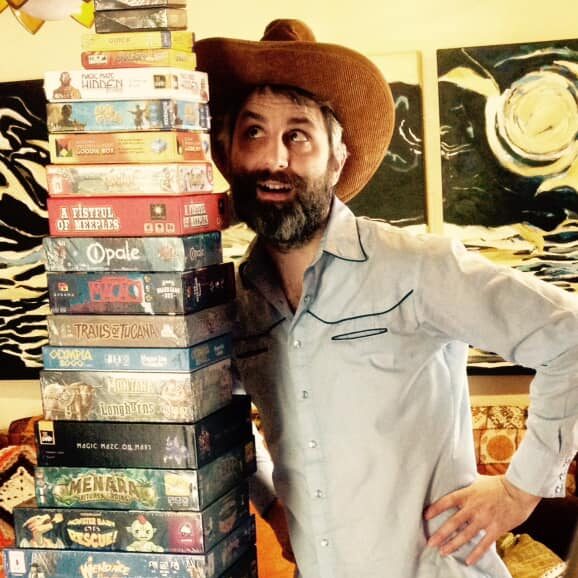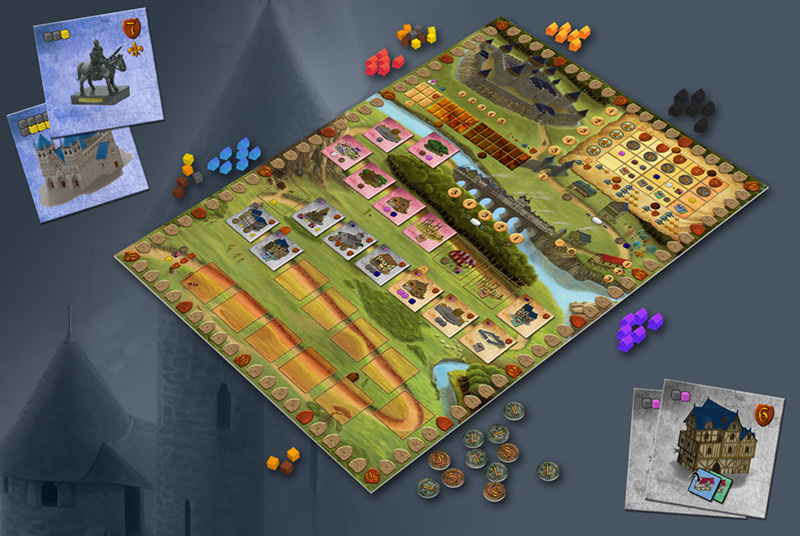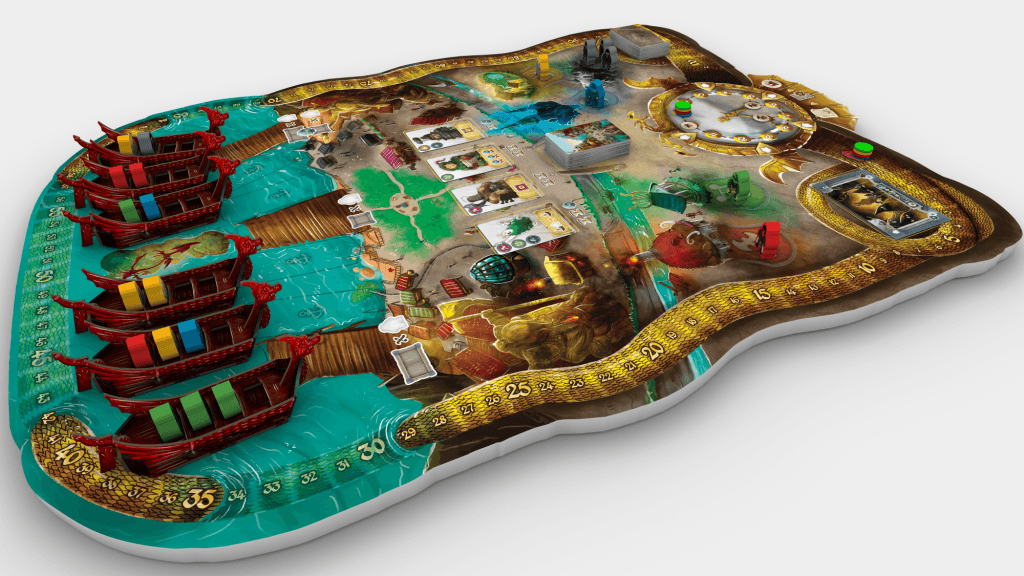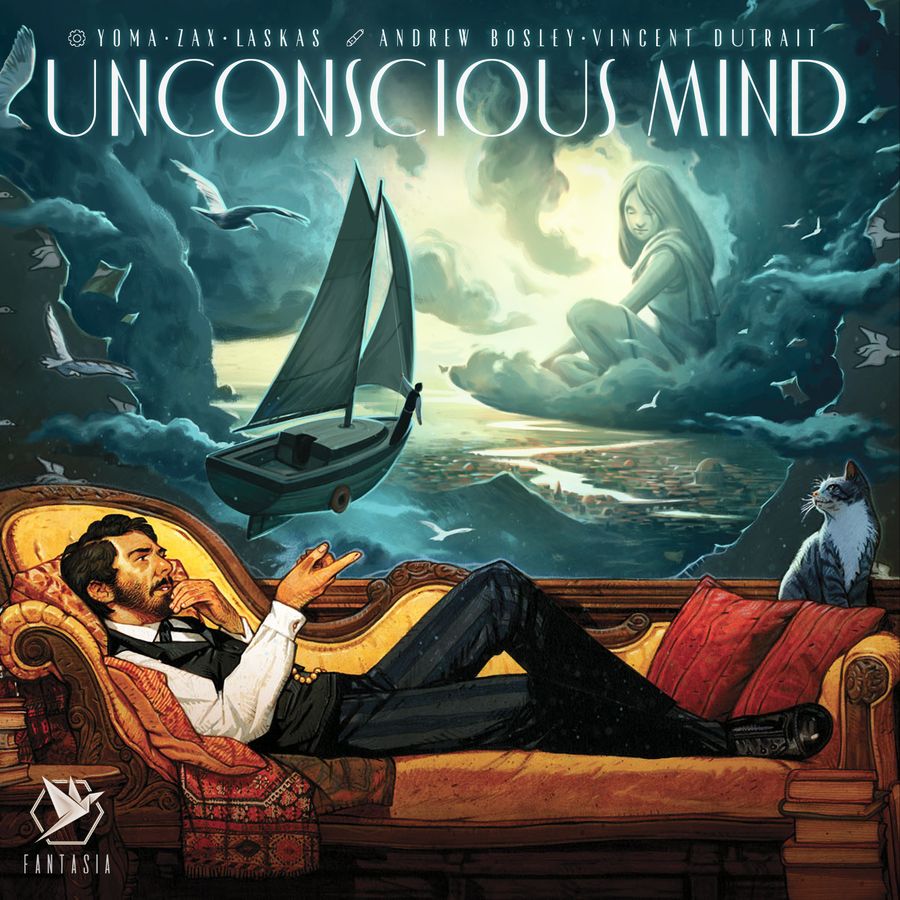From time to time I like to have a chat with people in games, in one way or another. Earlier this year I managed to grab some time with one of my favourite designers, Alex Pfister, and now I’m delighted to say I’ve managed to snag another. Jonny Pac is the cowboy-hat-wearing designer of Coloma, Sierra West, and one of this year’s big hits, Merchants Cove. He’s also the developer on the current Dranda Games Kickstarter, Solar Sphere. Here’s what he had to say.

The interview
Me: Hi Jonny, thanks for finding some time for me. Let’s start with something nice and easy. When you’re not designing or playing games, what are your favourite things in the world to do?
Jonny: I am a musician and composer, so I enjoy playing instruments, writing songs, and listening to albums. Before I became a full time game designer/developer, teaching private music lessons was one of my main gigs. I also enjoy collecting vintage knickknacks, reading about behavioral economics and pop science, swimming in rivers, and playing disc golf (amateur). I’m a pretty eccentric character overall, with a lifelong interest in arts and crafts. Game design fits right into that. I also like cats and tea.
Me: Sounds like you’ve got plenty to keep you busy! I know your early love of games came in the early 2000s with the likes of Puerto Rico and Stone Age. Which of those early games do you still play, and why?
Jonny: I do love eurogames from that era, from Carcassonne to Caylus in complexity. As with music, I like to study the artists who pioneered the styles I play, such as Miles David with modal jazz, and the Beatles with pop-rock. With eurogames, I often turn my attention to designers such as Kramer, Kiesling, Dorn, Feld, Dorra, Henn, Colovini, Cramer, Lehmann, Steding, Moon, and Knizia. And I don’t just play their mega-hits; I play their lesser-known games too, looking for hidden gems.

You can trace many contemporary designs back to games like Puerto Rico and Stone Age—even if those games are not as popular as they once were (or have questionable settings). There’s a wealth of interesting mechanisms in those older titles—and often more player interaction than you see in today’s euro games, which sometimes get criticized for being “multiplayer solitaire.”
Me: I know what you mean. When people tell me Euros aren’t interactive enough I always recommend they go back and play Caylus, Hansa Teutonica, or Troyes. For you personally, what was the turning point when you went from “I love playing these games”, to “I think I can make these games”? Was there a ‘Eureka’ moment?
Jonny: Well at first, I was a bit intimidated by knowing that genius designers such as Knizia were math wizards. As a player, I was always amazed at the numbers and distributions I’d see in eurogames—and how they were somehow “balanced” by some elegant math formulas beyond my capacity. Math was never one of my strong suits. But after reverse-engineering a few games, I started seeing simple, repeating patterns. For example, the number sequence 1, 3, 6, 10, 15, 21, which we see so often in games, is stock “triangular scoring,” not something so wild after all. It’s just a useful pattern many designers use, giving proper incentives for set-collection and such. As I became more confident in understanding these kinds of numbers, nonlinear systems, and basic behavioral economic principles, I started to think about making my own games. I took my first swing at board game design in 2012.
Me: I know you worked very hard in the early days to make your games a reality. If you had to give a new designer one piece of advice to make their dream come true, and see their game in stores, what would it be?
Jonny: Some aspiring designers say, “I just want to see my name on the front of a game box.” Well, really, that’s not too hard to achieve—but you might regret it. You should want your name on a game box you’re actually proud of. If that means waiting for the right publisher or opportunity to arise, that’s fine. It’s worth it.
Having a game out there that you’re not happy with is like getting a bad tattoo—you’ll probably have to live with it the rest of your life. I have both: questionable games and tattoos. Follow your dreams—and don’t let them become nightmares.
Me: Wise words, I really like the tattoo analogy. Your games and personal vibe seem to really draw from your part of the world, over there in the Sierras. When games like Coloma and Sierra West were starting to take shape in your head, which came first: the mechanisms, or the theme and narrative?
Jonny: I often start with a mashup of mechanisms I think “sound good” together, rather than one “riff” as we might say in music. As soon as I get that core system working, I look for a theme that will guide the rest of the design. I rarely come up with a complete game and try to slap a theme on it last minute. I think of my design process as thematically informed. And I try to work within settings I can treat properly, such as the Wild West. I’ve grown up with Gold Rush history all around me, so that’s an easy one.
Me: More recently though, the likes of Merchants Cove and Lions of Lydia have taken your themes in different directions. What plans do you have to bring your games back to California and draw on the stories there?

Jonny: I have hopes to make a game about the infamous Donner Party. But that will take a brave publisher to handle that setting tastefully (no pun intended). In contrast to my Gold Rush games, working on Lions of Lydia took quite a bit more research to make the theme and mechanisms gel properly—yet even that game was inspired by the setting: the first use of coins as currency. The game arch moves from a resource based economy to a one dominated by coins.
Merchants Cove was set in Final Frontier’s “Five Realms” universe, which is a Lord-of-the-Rings-like world, full of The Mico’s whimsical art. It was fun to dabble in it, introducing some new characters. Their upcoming game Bardwood Grove is also set in the Five Realms, and will have a lot of fun musical elements in there. I’ve enjoyed seeing it evolve in the last year.
Me: And while we’re talking about different themes, the recently-announced Unconscious Mind sounds really interesting. A game set around early 20th century Vienna, where players are members of Freud’s Psychoanalytical Society. It’s a very different style of theme for you, and it sounds like it might be a hard sell for some. Psychoanalysis in Austria might not have the same draw as striking it rich in the Gold Rush. Why do you think we should get excited for this game?
Jonny: Unconscious Mind is the next big project from Fantasia Games. Their first project was Endless Winter, which I developed and designed the expansions for. It was one of the most intense and rewarding projects I’ve worked on to date. Yoma, one of the owners of Fantasia (and the art director), co-designed Unconscious Mind with two of his good friends. He asked me to take a look at it on TTS and give my honest opinion on whether or not they should make it Fantasia’s sophomore effort. After just one play, I said yes! It’s a very tight eurogame, with a very interesting mashup of mechanisms that fit the setting quite well.
After that, I was invited to become the lead developer (and co-designer) and take the gameplay to the next level. The theme is fascinating—and Yoma’s crazy idea to use two famous artists to divide the real world and dream world is nothing short of brilliant. The box cover says it all: in the foreground, you see Vincent Dutrait’s depiction of a real-world patient reclining on a couch—then above him the walls break away into Andrew Bosley’s illustrations of the dream-world…

Me: I spoke to the guys from Dranda Games at the recent UK Games Expo, and they told me a bit about your involvement with their new game, Solar Sphere. How did you come to get involved with the project?
Jonny: I met Simon Milburn at Essen 2019 at the Alley Cat Games booth (he’s their lead developer). After some time in 2020 he asked me to pitch my designs to his new company, Dranda Games, which he co-founded with Ayden Lowther. They took a look at one of my yet-to-be-signed Westerns, Claim Jumpers. They eventually passed on it, but wanted to see if I’d consider developing the follow-up to their game Solar Storm, Solar Sphere. After a session on TTS, I was sold. It had some really cool things going on—especially the “drones” which are the game’s secret sauce. I agreed to develop it and create two expansion modules.
It’s been a real pleasure working with them, and at the time of this writing the game is on Kickstarter, pushing $85,000 and 1,300 backers. I suspect it will go beyond 100K by the end of the campaign. And I believe the game will have legs in retail after it is fulfilled, given just “how much game there is” in a relatively small box.
Me: Finally, what else is in the pipeline for you at the moment, what would you like to tell us about?
Jonny: Right now, I am trying to better focus my efforts, after a long stretch over being over-committed to projects. I felt spread thin, and wasn’t really able to make time for proper self-care. But that said, I have design/development projects of various shapes and sizes in the pipeline with Fantasia, Final Frontier, Alley Cat, Crafty, Elf Creek, Talon Strikes, and others. We’ll see most of those roll out in 2022-23. I also have a handful of unsigned prototypes I might look to pitch. But I’m in no rush. I want to be proud of every game with my name on it, quality over quantity.
Me: Absolutely the right mindset. I’m excited to see what comes over the next few years. Thank you so much for your time, Jonny, I know you don’t have much to spare, so I’m very appreciative.
If you enjoyed this interview, you can read more here.
